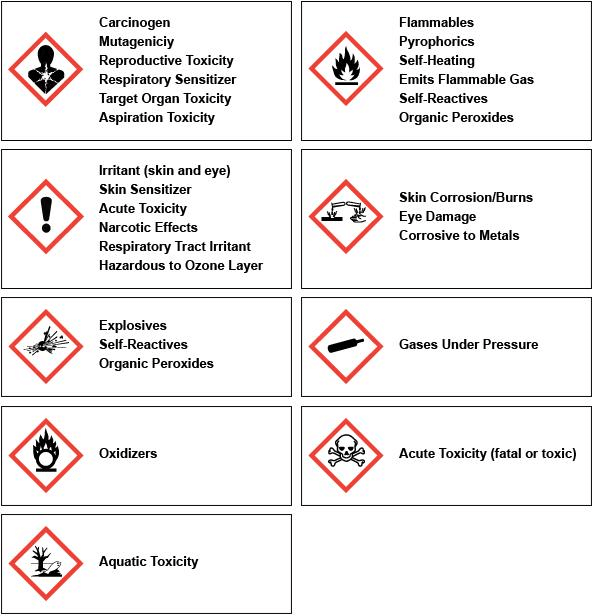.jpg?width=320&name=ghs-1%20(1).jpg) Using the right pictograms on your Globally Harmonized System (GHS) labels makes a significant difference in effectively communicating material hazards and improves the safety of your workers and customers.
Using the right pictograms on your Globally Harmonized System (GHS) labels makes a significant difference in effectively communicating material hazards and improves the safety of your workers and customers.
Under the 1994 Hazard Communication (HazCom) Standard labelling requirements were performance based. This means that employers had a lot of choice on which information to display as long as the label clearly demonstrated improvements in mitigating workplace incidents under the revised 2012 HazCom labeling requirements are guided by the Globally Harmonized System’s standards. GHS labels are standardized and specific information is assigned to each of the hazard categories. Based on the “Right-to-Understand,” this approach will ultimately provide consistency in the presentation of chemical data and provide immediate recognition of the hazards.
This short article will provide essential information for anyone who needs to author, understand, or share GHS style labels for the chemicals and materials used in their workplaces.
What’s in a GHS Label?
A GHS Label for a hazardous chemical must contain 6 specific pieces of information:
- Name, Address and Telephone Number of the material supplier
- Product Identifier
- Signal Word
- Hazard Statements
- Precautionary Statements
- Pictograms
How does Labeling work?
For manufacturers, all hazardous chemicals shipped after June 1, 2015, must be labeled with specified elements including pictograms, signal words and hazard and precautionary statements. Distributors have until December 1, 2015 to distribute products with old labels and SDSs. Prior to these deadlines, manufacturers and distributors are strongly encouraged to begin the process of reclassifying their hazardous chemicals in order to update their labels.
When you have a product, you must first classify the chemical health hazards and physical hazards. If you want to learn more about how to do this, read ERA’s how-to article on GHS classifications. Once a hazard is classified, you must communicate the corresponding signal word, hazard statements, precautionary statements and pictograms on the label and Safety Data Sheet (SDS). Pictograms are a standardized set of simple to understand symbols. Using these simplified symbols instead of a numbered rating system on labels and SDSs promotes understanding and eliminates language barriers.
GHS Label Sections
Sections of the GHS are covered in this section:
Product Identifier
This section identifies the hazardous chemical with a product ID and name. Make sure the name and ID are the same on the material’s label and the Safety Data Sheet.
Signal Words
This section will include either the word Danger or Warning, depending on the severity of the highest possible hazard associated with the material’s chemicals. Danger represents the high degree of risk. Signal words give the reader an immediate picture of the risk level associated with handling a material.
Hazard Statements
Hazard statements are taken from a set of standardized GHS statements that describe the type of dangers a material presents. Hazard statements:
- Describes the nature and degree (if possible) of the hazard. For example, a hazard statement should let the reader know if the materials present a physical danger or a health risk.
- Statements may be combined when necessary. Some materials may have several statements while others may have only one.
- Statements are specific to hazard classification categories.
Precautionary Statements
Precautionary statements describe the actions that anyone using the material should take to minimize or prevent harmful exposures. There are four types of precautionary statement: prevention, emergency response, storage, and disposal. An example of a precautionary statement might be “wear protective goggles” – this is a prevention statement. “Do not induce vomiting” would be an emergency response statement.
Supplementary Information
This section is not listed in the list of mandatory label section, as many materials will not require this information. Supplementary information should include:
- Additional instructions for handling the material that aren’t covered by the GHS precautionary statements.
- Hazards not otherwise classified (HNOC). Some chemical hazards are not classified by the GHS guidelines, but should still be communicated in labels and SDSs. Lookout for ERA’s upcoming guide to GHS classifications and categories for more information on HNOCs.
- This section must also identify the percentage of ingredient(s) of unknown acute toxicity when it is present in a concentration of ≥1%.
Pictograms
Pictograms are the standardized symbols used to quickly give material handlers a picture of the type of hazards the material presents. Many GHS pictograms will be familiar to North American consumers, as many of them have remained the same from the U.S. and Canadian HazCom regulations.
GHS pictograms:
- Are always framed within a red square frame set on point . The image itself is always a black symbol on a white background. This means that some manufacturers will need to upgrade their systems to print color labels or start using pre-printed labels. There are a total of 9 possible pictograms (OSHA only enforces 8).
- Below are of the GHS pictograms that can be featured on a label along with the hazards each one is associated with.

Sample Label
The below image is a sample label that follows the new GHS guidelines. As is shown in the label, the material has two hazard statements (one physical, one health) and several precautionary statements.
What about Work-place Labels (AKA Secondary Container Labels)?
Hazard communication is also required for any containers that a material has been transferred to from the material’s primary shipping container. These containers are known as Secondary Container labels, but are more commonly called work-place containers or in-plant containers.
Employers must ensure that all container labels correctly communicate the new GHS hazard categories and classifications. However, these secondary container labels can be performance-based, as their regulations were developed prior to HazCom 2012 standards. GHS guidelines require that these labels still communicate the same level of understanding that the primary shipping label provides. This means you can use signs, batch tickets, and other writing materials instead of a label as long as all the necessary information is conveyed.
Though the requirements for workplace labels are more flexible, the best and fastest practice is to replicate the information found on the shipping label. A good labeling system will be able to generate GHS compliant shipping and workplace labels easily to provide accurate information to employees in the most compliant manner.
If you are transferring hazardous chemicals into a portable container for immediate use, note that you do not have to label it.
GHS compliant labels should be incorporated into your SDS management system. If you are thinking of redesigning your system in light of the new GHS SDS and Label formats, check out our eBook.
Ask an ERA Expert:
Are you transitioning to the GHS in your business? Do you have any questions or concerns about the topic covered in this article? Want more insight? Now is your chance to ask one of ERA’s Environmental Specialists. Please leave your question or comment below and we’ll make sure one of our expert scientists responds.
This Blog was Co-Authored By:


April 14, 2014

%20(1).png?width=589&name=file-643913105%20(1)%20(1).png)

Comments